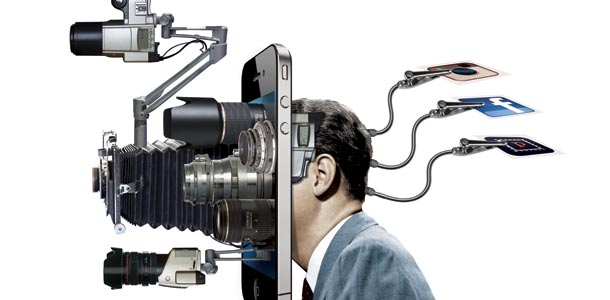How To Copy Photos From Photos App To Separate Folder

Illustration by Viktor Koen

Late in 1975, a young electrical engineer named Steven Sasson finally flipped the switch on a Rube Goldbergian contraption that he'd been working on for more than a year. It was a camera that captured a photograph without using any film. The device was huge, ugly, and took 23 seconds to record an image with a resolution of only 0.01 megapixels. When Sasson showed the gadget to his bosses, they were dumbfounded. "Why would anyone ever want to view his or her pictures on a TV?" they wondered, as he wrote in a blog post decades later. Sasson earned a patent for his trouble but otherwise his project was forgotten.
The company that was contemptuous about pictures on screens is now on the verge of bankruptcy. In a single day in September, its stock plunged 60%. The outfit that failed to commercialize the first digital camera? You guessed it: Kodak.
Before we mock the once-legendary company, remember that photography has careened in unexpected directions since its invention and no one company has ever been able to predict which corner of our lives it'll capture next. Indeed, for a medium that hit the mainstream during the Civil War, photography has become the digital era's most reliable hit maker. Seemingly every week, there's a new app, website, gadget, or online service looking to remake how we capture and share images. The list of hot startups built around photos would make any VC reach for his checkbook: There are app-based social networks such as Instagram and Path, new devices (Eye-Fi, Lytro), picture-book makers (Blurb), filters that appeal to every stylistic aesthetic from noir to Super 8 (iSupr8), and even digital inspiration boards, such as Pinterest and Fancy, that traffic in users curating their desires through images. And then, of course, there's the biggest of them all: Facebook, whose sole utility, for hundreds of millions of people, is sharing pictures. Photos are now every platform's killer app.
Photography's renaissance rests on a few unbeatable advantages. Compared to other kinds of content–songs and movies–photos are, technically and legally, much easier to share and mash up. If you come up with a great, unexpected new site centered on TV shows, you need to get huge servers and pay for expensive bandwidth and licensing deals. If you've got a fantastic new take on photos, often all you need is an app. That app lives on a smartphone, which is the world's most popular point-and-shoot camera. For the first time, cameras are connected to the Internet, they know who your friends are, they know where you are, and they can be constantly updated with new powers. The camera is powerful (Apple's iPhone 4S is 8 megapixels) and intelligent, and the pictures keep getting more interesting.
But the real magic is the photograph's unyielding power to keep wowing us. "What really got me excited is the value somebody gets when they receive a photo as a gift," says Matt Brezina, cofounder and CEO of Sincerely, a startup that turns users' digital photos into tangible ones. "If you walk down the street and ask anybody, Would you like to get a photo in the mail from a friend? every single person would like that. Not everybody wants a box of chocolates or a bottle of wine, but everyone wants a photo."
Brezina's firm has created several apps to realize this; among them is Postagram, which turns Instagram's Polaroidy photos into cards for 99 cents. The concept is so blindingly cool that even Apple has co-opted it with its new Cards app, though for three times the price.
Kodak, the firm that started it all, is now reduced to trolling for royalties on its many digital-imaging patents. It may find a few licensees, but if it were smarter, Kodak would ditch the lawyers and hire a few hundred developers. People's appetite to do unexpected things with photos is limitless–and, as many services have shown, we're willing to pay for the privilege. Now that photos are everywhere, this could be Kodak's moment, once more.
How To Copy Photos From Photos App To Separate Folder
Source: https://www.fastcompany.com/1793484/photos-are-new-killer-app
Posted by: spencerprawn1984.blogspot.com

0 Response to "How To Copy Photos From Photos App To Separate Folder"
Post a Comment